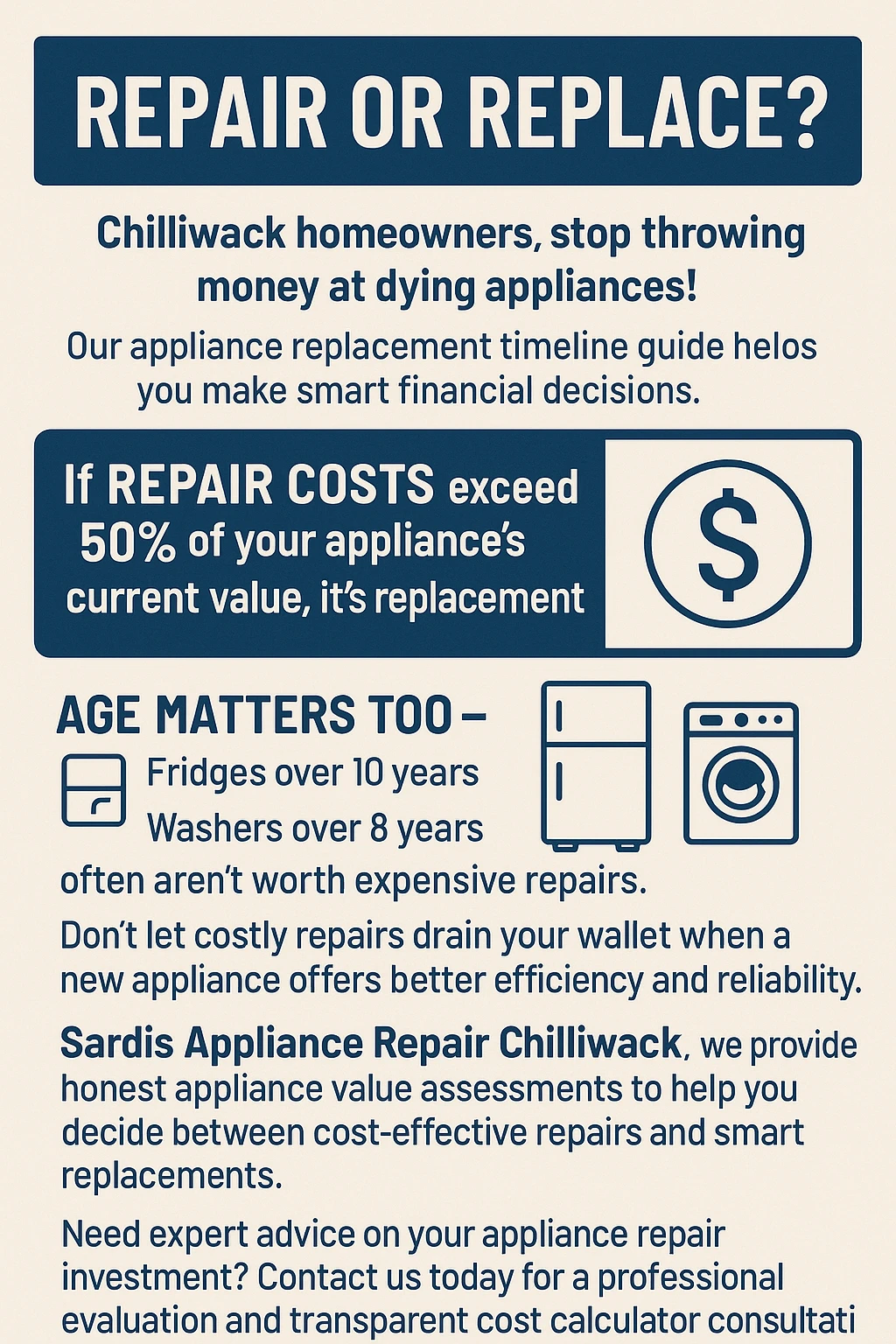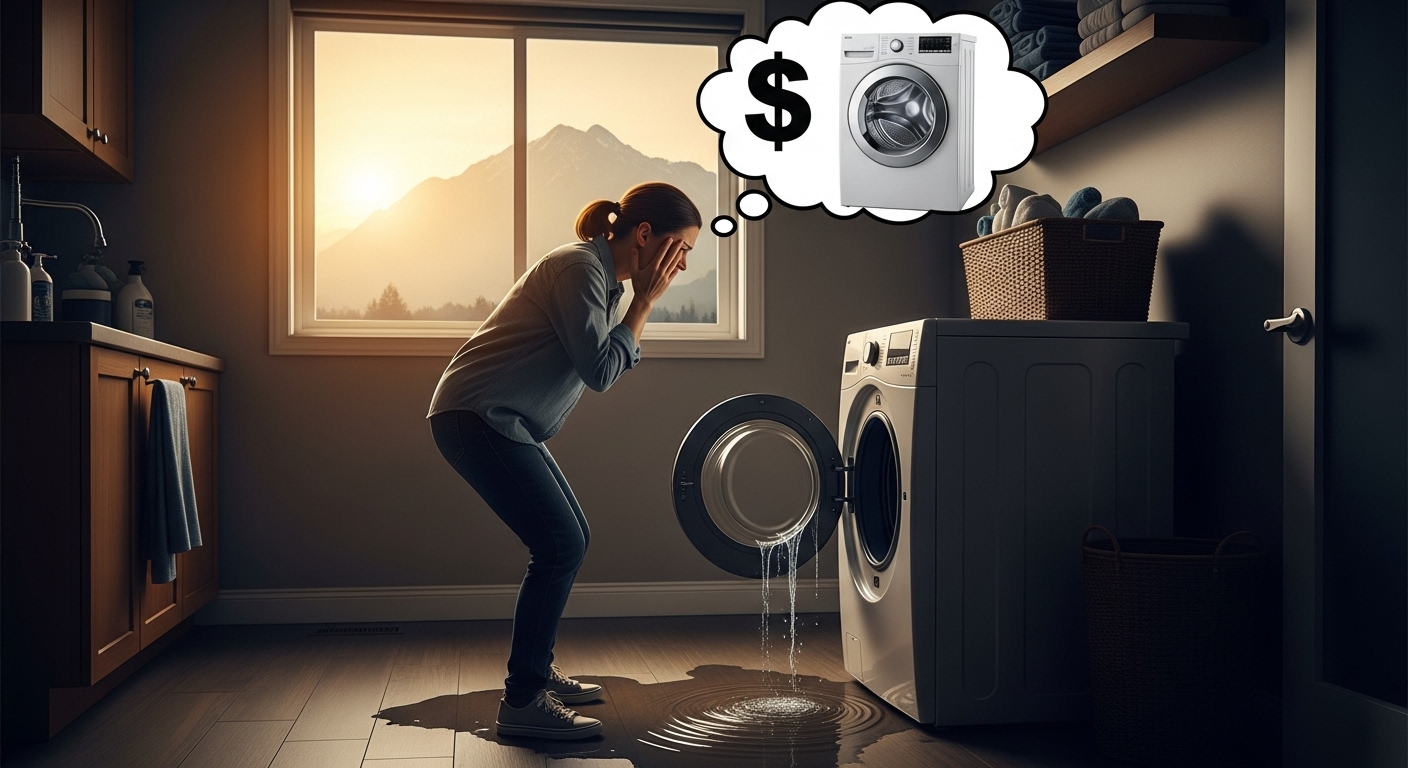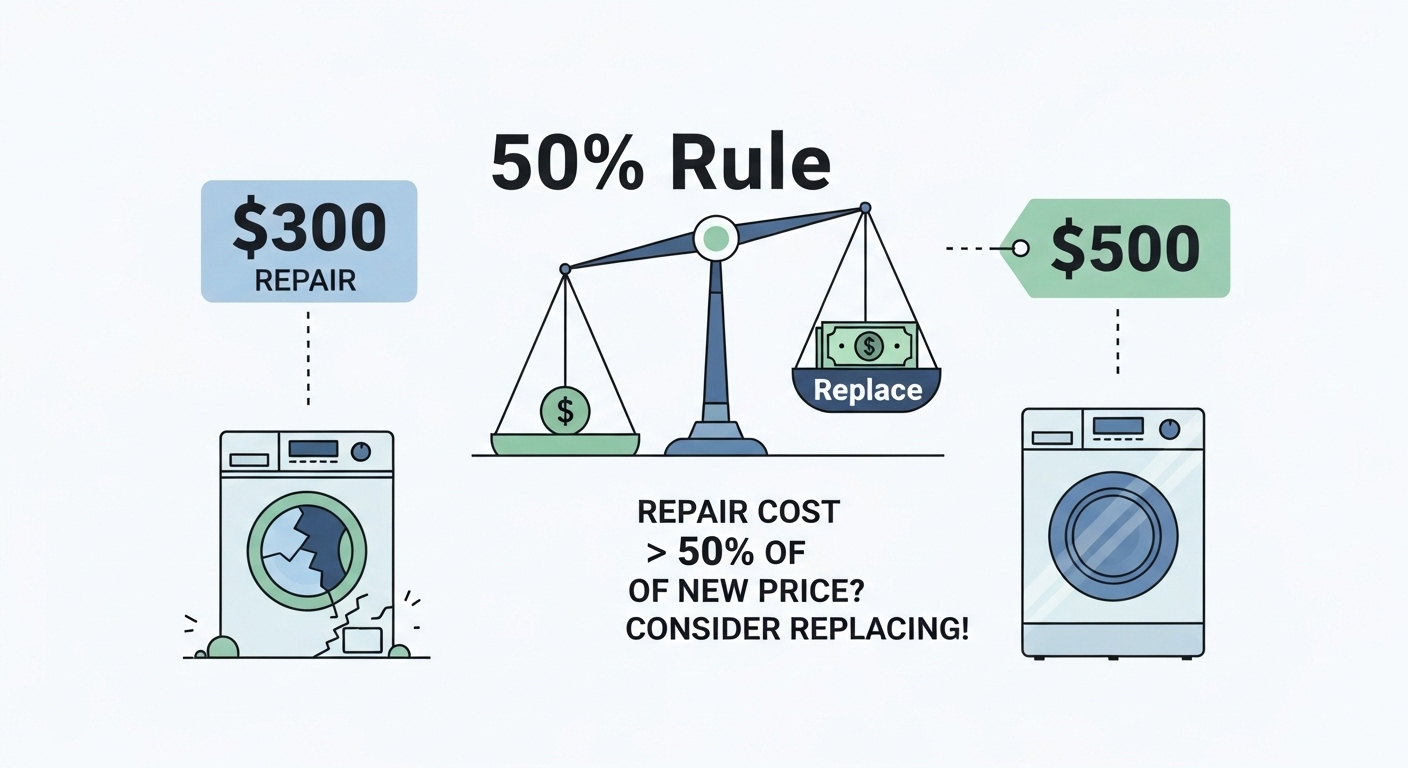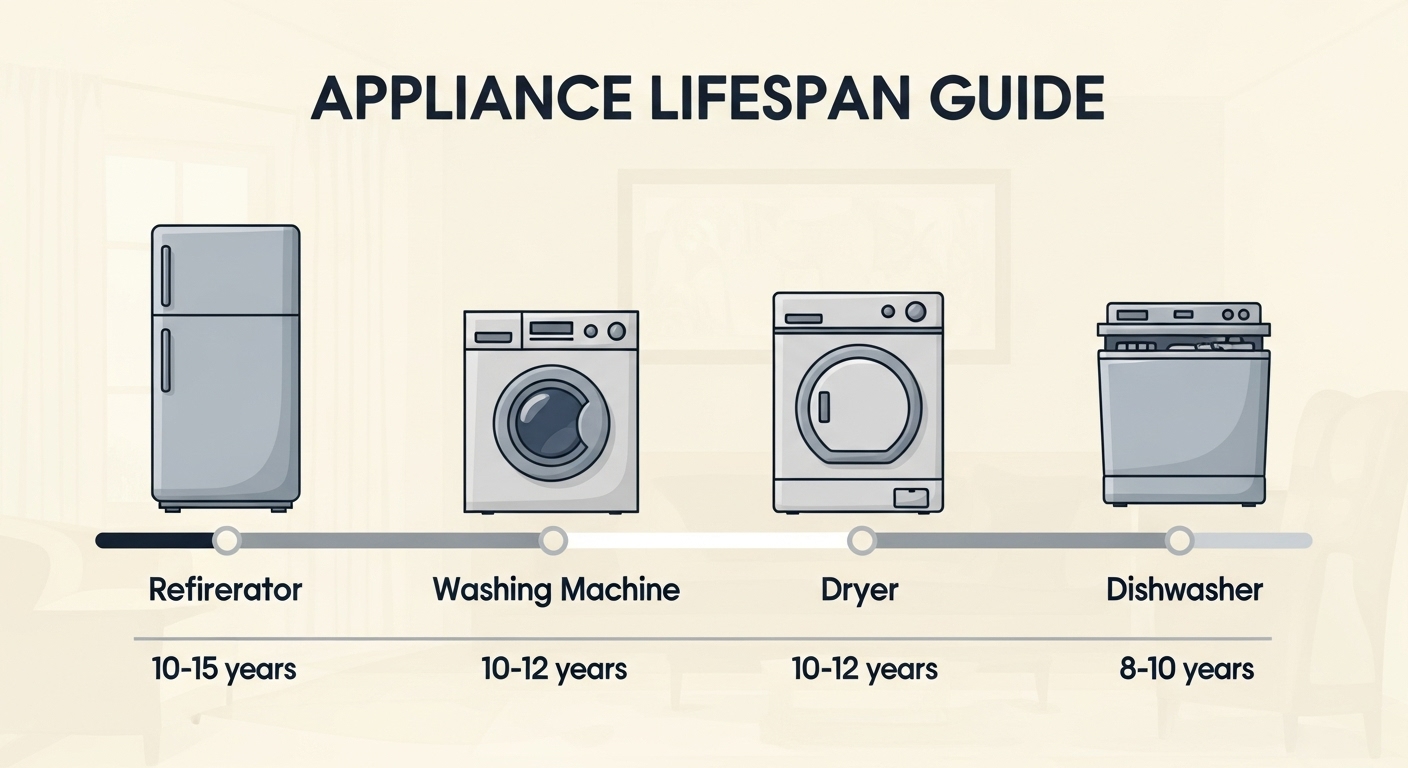The Appliance Replacement Timeline: How to Know When Repair Costs Exceed Your Appliance’s Value (A Chiliwack Homeowner’s Financial Guide)
Staring at your broken dishwasher while mentally calculating whether that $300 repair quote makes sense, or wondering if your decade-old fridge is worth fixing again? You’re not alone—navigating the repair versus replacement decision can feel like playing financial roulette, especially in Chiliwack’s current market where appliance prices have skyrocketed while quality repair services remain surprisingly affordable.
Picture this: It’s Tuesday morning, you’re rushing to get the kids ready for school, and suddenly your washing machine decides to throw in the towel (literally—water everywhere). The repair tech gives you that look, the one that says “this is gonna hurt your wallet,” and suddenly you’re faced with one of homeownership’s most frustrating dilemmas. Do you sink more money into your faithful but aging appliance, or bite the bullet and shell out for a shiny new replacement?
Living in Chiliwack, we’ve got some unique challenges that make this decision even trickier. Our beautiful Fraser Valley location comes with humidity that can wreak havoc on appliances, seasonal service availability that can leave you hanging when you need help most, and BC Hydro rates that make energy efficiency more important than ever. Meanwhile, appliance prices have jumped 20-30% in recent years, making that repair option look increasingly attractive.
The good news? There’s actually a systematic way to approach this decision that takes the guesswork out of the equation. By understanding local repair costs, appliance lifespans, and the true value of energy efficiency in our region, you can make informed choices that save money and prevent those middle-of-winter appliance emergencies that always seem to happen at the worst possible moment.
Key Outtakes:
- Apply the 50% rule as your baseline: replace when repair costs exceed half the price of a comparable new appliance
- Appliances over 10-15 years old typically favor replacement due to declining efficiency and increasing failure rates
- Chiliwack’s Fraser Valley climate accelerates appliance wear through humidity and temperature fluctuations, making proactive maintenance crucial
- Energy efficiency improvements in newer models can offset replacement costs through reduced BC Hydro bills over time
- Seasonal timing and local service availability significantly impact repair versus replacement economics in our region

Understanding True Appliance Repair Costs in the Fraser Valley

Before you can make an informed repair versus replacement decision, you need to understand what you’re really paying for when that service truck pulls into your driveway. The Fraser Valley region has developed its own pricing structure that’s both competitive and reflective of our unique service challenges. Most local appliance repair companies charge a flat diagnostic fee upfront, typically around $139, regardless of whether you proceed with the repair or not.
What catches many Chiliwack homeowners off guard is how repair costs break down beyond that initial diagnostic. Labor charges generally run between $50-100 per hour depending on the complexity of the work and the technician’s expertise level. Simple repairs like replacing a dishwasher filter or fixing a loose dryer belt might only require 30 minutes of work, while complex issues like replacing a refrigerator compressor could take several hours.
Parts costs vary dramatically depending on your appliance’s age and brand. Common components like heating elements, pumps, or control boards for mainstream brands like Whirlpool or GE typically cost $50-200. However, if you own a high-end European brand or your appliance is over 10 years old, parts can easily cost $300-500 or more. This is where many repair decisions become clear-cut—when the part alone costs more than half of a new appliance’s price.
The total picture for appliance repairs in our region typically ranges from $100-400 for most common issues. However, don’t forget to factor in the hidden costs of replacement that make repairs more attractive. New appliance installation fees range $100-500, delivery charges add another $50-100, and disposal of your old unit costs $75-150. These additional expenses can easily add $300-600 to your replacement costs.
Understanding local service availability is crucial for Chiliwack residents. During winter months, when heating systems work overtime and humidity levels fluctuate wildly, appliance failures spike. Emergency service calls during weekends or holidays can cost $140-400, making planned maintenance and proactive replacement much more economical than reactive emergency repairs.
The 50% Rule and Age-Based Decision Matrix
The appliance repair industry has long relied on what’s known as the 50% rule as a quick decision-making tool. This guideline suggests that if your repair cost exceeds 50% of what you’d pay for a comparable new appliance, replacement typically offers better long-term value. However, this rule requires some nuance when applied to Chiliwack’s specific market conditions and the realities of modern appliance shopping.

When calculating the 50% threshold, make sure you’re comparing apples to apples. If your 12-year-old dishwasher needs a $350 repair, don’t compare that to the cheapest new model you can find online. Instead, look at what it would cost to replace your unit with something of similar size, features, and build quality. A basic new dishwasher might cost $600, but if yours has features like a third rack, stainless steel interior, or quiet operation, the comparable replacement could easily cost $1,200-1,500.
Age plays a critical role in this calculation beyond simple math. Appliances under five years old almost always favor repair, assuming the issue isn’t a fundamental design flaw. These units typically still have reasonable parts availability, may have remaining warranty coverage, and haven’t yet experienced the cumulative wear that leads to multiple system failures.
For appliances in the 5-10 year range, the decision becomes more complex and depends heavily on the specific issue and your appliance’s maintenance history. A well-maintained refrigerator that’s had regular coil cleaning and proper care might be worth a $400 compressor replacement at eight years old. The same repair on a neglected unit that’s already had multiple fixes probably isn’t wise.
Once appliances hit the 10-15 year mark, replacement usually makes more financial sense, even for expensive repairs. At this age, you’re dealing with outdated energy efficiency, declining reliability, and the likelihood that today’s repair will be followed by another issue within 12-18 months. The exception might be simple, inexpensive fixes that buy you time to plan and budget for replacement on your terms rather than in an emergency.
Extended warranties deserve special mention in this decision matrix. These typically cost $100-300 for 3-5 years of coverage but usually cover parts costs while excluding labor charges. Given that labor often represents 50-70% of repair costs in our region, extended warranties rarely provide the value they promise.
Appliance Lifespan vs. Repair Investment Analysis
Understanding realistic appliance lifespans helps you make informed repair decisions by revealing how much useful life you’re purchasing with your repair investment. However, published lifespan data often reflects ideal conditions that don’t account for our Fraser Valley climate and usage patterns. Real-world lifespans in Chiliwack tend to run 10-20% shorter than national averages due to humidity-related stress and temperature fluctuations.

Refrigerators typically last 10-15 years under normal conditions, making them worthwhile repair candidates until around year 12. These workhorses depreciate slowly because they run continuously, meaning a major repair at year 8 could still provide 4-6 years of additional service. However, refrigerator compressor failures after year 10 usually signal replacement time since other systems will likely follow.
Washing machines and dryers fall into the 10-12 year lifespan category, but their repair worthiness varies dramatically by issue type. Drive motor replacements at year 7-8 often make sense, while control board failures in the same timeframe frequently don’t due to the high cost of electronic components. Front-loading washers face additional challenges from seal and bearing failures that can cost $400-600 to repair properly.
Dishwashers have the shortest typical lifespan at 8-10 years, largely due to their exposure to food debris, grease, and harsh detergents. However, they
 (604) 305-2992
(604) 305-2992 
 Schedule An Appointment
Schedule An Appointment 